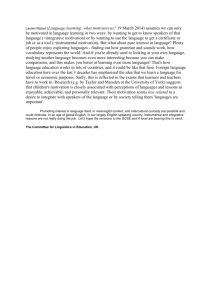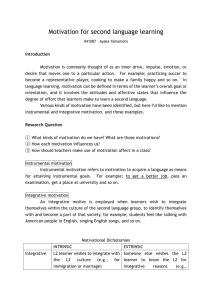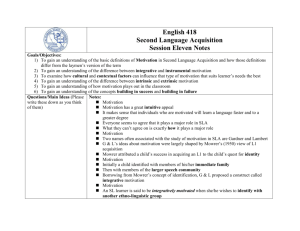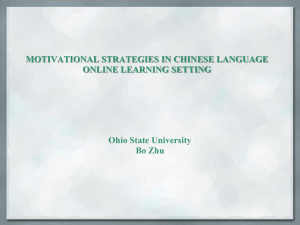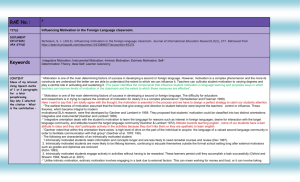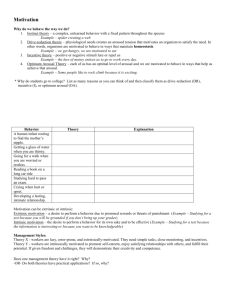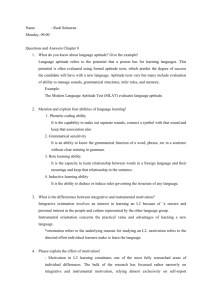the integrative
advertisement
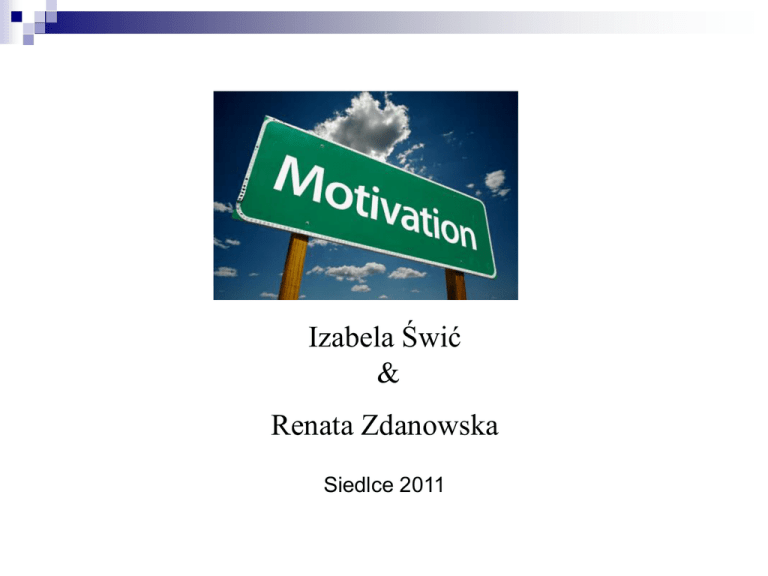
Izabela Świć & Renata Zdanowska Siedlce 2011 Definition of motivation • Motivation is the most frequently used catch-all term for explaining the success or failure of virtually any complex task. • Many studies and experiments in human learning have shown that motivation is a key to learning in general. • In the field of second language acquisition, in particular, the subject of motivation has garnered plenty of attention. Definition of motivation • Motivation is an integral part of learning a second language. It is learning how to keep on being motivated that is the key to language fluency. • Motivation is often defined as the psychological quality that leads people to achieve a goal. The goal for language learners is mastery of a language. Theories of motivation The term motivation theory is concerned with the processes that describe why and how human behavior is activated and directed. Three views of motivation • Behavioral Views of Motivation; • Cognitive Views of Motivation; • Constructivist View of Motivation Behavioral Views of Motivation Behaviorism suggests that motivation results from: • Effective reinforcers; • Anticipation of reward; • External forces like parents, teachers, peers, educational requirements etc. Critics of behavioral approaches to motivation contend that reinforcers detract from intrinsic motivation and cause learners to focus on the reinforcers instead of learning. Reinforcers can be effective, however, if they’re based on quality of the work and communicate increasing competence. Skinner, Pavlov, Thorndike put motivation at the center of their theories of human behavior. • Skinner demonstrating that organisms tend to repeat actions that are reinforced and that behavior can be shaped by reinforcement, • Skinner developed the technique of programmed instruction to make it possible for students to be reinforced for every correct response. • According to Skinner, supplying the correct answer--and being informed by the program that it is the correct answer--motivates the student to go on to the next frame; and as the student works through the program, the desired terminal behavior is progressively shaped. Cognitive Views of Motivation Cognitive views places much more emphasis on the individual’s decisions. The choices people make as to what experiences or goals they will approach or avoid, and the degree of effort they will exert in that respect. Cognitive theories of motivation focus on learners’ beliefs, expectations, and needs for order and understanding . Six needs undergirding the construct of motivation by Ausubel: Exploration – for seeing the other side of the mountain; Manipulation – for operating on the environment and causing change; Activity – for movement and exercise both physical and mental; Stimulation - by the environment, by other people, by ideas, thoughts, feelings; Knowledge – need to process the results of exploration, manipulation, activity and stimulation to resolve contradictions, to quest for solutions to problems and for self-consistent systems of knowledge; Ego enhancement – for the self to be known and to be accepted and approved of by others. Constructivist view of motivation Constructivist view of motivation places emphasis on social context as well as individual personal choices. Each person is motivated differently, and will therefore act on his or her environment in ways that are unique. These unique acts are always carried out within a cultural and social milieu and cannot be completely separated from that context. Maslow's motivation theory The basis of Maslow's motivation theory is that human beings are motivated by unsatisfied needs, and that certain lower factors need to be satisfied before higher needs can be satisfied. According to Maslow, there are general types of needs (physiological, survival, safety, love, and esteem) that must be satisfied before a person can act unselfishly. He called these needs "deficiency needs. „As long as we are motivated to satisfy these cravings, we are moving towards growth, toward self-actualization. Satisfying needs is healthy, while preventing gratification makes us sick or act evilly. Studies of motivation in second language acquisition often refer to the distinction between integrative and instrumental orientations of the learner. Orientations Instrumental furthering a career reading technical material translation Integrative integrating into the culture of the second language becoming involved socially Motivation or orientation? • Dornyei, Gardner and MacIntyre point that instrumentality and integrativeness are not types of motivation. high motivational intensity low motivational intensity Research studies 1 Spolsky (1968) 'Integrativeness' gets higher scores in proficiency tests in learning L2 Gardner & Lambert (1972) 2 Lukmani (1972) 'Instrumentality' gets higher scores in proficiency tests in learning L2 Research studies 3 Gardner & MacIntyre (1992) In certain contexts either instrumental or integrative orientation were more effective 4 Gardner (2004) Lamb (2004) It is difficult to distinguish which orientation has better impact on tests' results What is more effective? • There is no single means of learning of a second language Some students are more successful if they are integrative orientated Some students need an instrumental factor to be successful Why is that? Most situations 'contain' a mixture of both orientations and the integrative – instrumental construct is able to bring student to his/her success in language learning. Motivation Intrinsic belonging to or part of the real nature of somebody or something, true; genuine; real; essential Extrinsic not belonging naturally to somebody, coming from outside somebody or something rather than within them Intrinsic motivation intrinsically motivated activities are these for which there is no reward except the activity itself COMPETENCE AND SELF-DETERMINATION Extrinsic extrinsic motivation comes from outside and beyond the self MONEY, PRIZES, GRADES, POSITIVE FEEDBACK, AVOIDING PUNISHMENT Which form of motivation is more powerful? “An unpublished study reported an experiment in which two groups of junior high school girls were asked to teach a simple game to kindergarteners”. 1. A reward. 2. No reward. Results and conclusion • “The results showed that the latter group did a better job of successfully teaching the game and reported greater satisfaction in doing so than the first group” • Intrinsic motivation in second group was a stronger motivator. Motivational dichotomies Intrinsic • • Extrinsic Integrative L2 L2learner learnerwishes wishes totointegrate integratewith with L2 L2culture culture Someone else wishes the L2 learner to know the L2 for integrating reasons Instrumental L2 learner wishes to achieve goals e.g., for a career External power wants L2 learner to study L2 e.g., business cooperation Sum - up • Motivation plays a significant role in the process of learning a second language. Language teachers cannot effectively teach a language if they do not understand the relationship between motivation and its effect on second language acquisition . • The core of motivation is what might be called passion. Passion, which relates to a person’s goals and desires, is intrinsic. Successful learners know their preferences, their strengths and weaknesses, and effectively utilize strengths and compensate for weaknesses. Successful language learning is linked to the learner’s passion. Instructors should find ways to connect to this passion. References H. Douglas Brown (2007): Principles of language learning and teaching, chapter 6. “Second Language Acquisition Through Motivation”, http://socyberty.com/languages/second-language-acquisition-through-motivation/ Jacqueline Norris-Holt, “Motivation as a Contributing Factor in Second Language Acquisition’’, The Internet TESL Journal, http://iteslj.org/Articles/Norris-Motivation.html ; Motivation to Learn Another Language (2008), http://www.suite101.com/content/motivation-to-learnanother-language-a66954 Motivation Excerpted from Chapter 11 of Biehler/Snowman, PSYCHOLOGY APPLIED TO TEACHING, 8/e, Houghton Mifflin, 1997. http://college.cengage.com/education/pbl/tc/motivate.html Theories of Motivation, http://wps.prenhall.com/chet_eggen_education_6/13/3460/885789.cw/index.html
